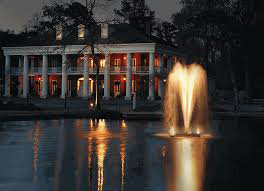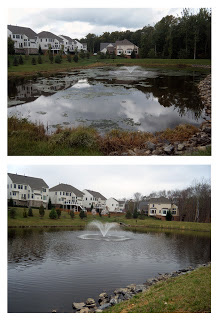IN NEED OF SOME CLARITY?
Many folks dream of living on a property that has it's very own large pond or lake. Those who are fortunate enough to live out this dream know that this luxury comes with a price. It is not uncommon to see natural lakes and ponds covered in "pond scum" all summer long. This "scum" is usually different types of algae and small floating plants that are feeding on the nutrients in the warm surface water. The ability for this unsightly floating mess to go wild on the water's surface makes for drab results. Luckily the solution is a simple one. Oxygen. What that body of water needs is some aeration! Aeration mixes air with the water and promotes the growth of beneficial (oxygen loving) bacteria. These bacteria eat the same nutrients that are supporting the unwanted pond scum.
What that body of water needs is some aeration! Aeration mixes air with the water and promotes the growth of beneficial (oxygen loving) bacteria. These bacteria eat the same nutrients that are supporting the unwanted pond scum. So the equation is simple: Good aeration = More bacteria and More bacteria = CLEAN WATER!
TOP OR BOTTOM?
So how exactly do we add oxygen to the pond water? There are two basic aproaches towards solving this problem: surface based aeration or sub-surface aeration.
 Surface aeration involves the installation of a floating fountain unit. Floating fountains are moored to the bottom so they will remain stationary. Pulling water from a few feet below the surface of the pond and spraying it out towards the edges pushing floating debris with it. This spray not only adds oxygen to the water but also tends to cool the water down. The movement creates a convection current within the pond causing the cold water from the bottom to be mixed with the warm water of the surface. Lower water temperatures make it harder for the unsightly pond scum to prosper and proliferate.
Surface aeration involves the installation of a floating fountain unit. Floating fountains are moored to the bottom so they will remain stationary. Pulling water from a few feet below the surface of the pond and spraying it out towards the edges pushing floating debris with it. This spray not only adds oxygen to the water but also tends to cool the water down. The movement creates a convection current within the pond causing the cold water from the bottom to be mixed with the warm water of the surface. Lower water temperatures make it harder for the unsightly pond scum to prosper and proliferate.
Sub-surface aeration does not have the benefit of a glamourous fountain display. In fact sub-surface systems are barely noticeable on the water's surface. These systems are comprised of a shore mounted compressor unit which supplies bottom mounted diffuser discs via weighted tubing. The system is basically invisible. The discs push out a column of very fine air bubbles which slowly rise to the surface. As they climb through the water column they drag along the colder water from the bottom of the pond or lake. Once the air hits the surface it escapes and the cold water is pushed away from the center towards the edges. This convection current cools the water's surface by mixing the pond to one uniform temperature.
A SHORE UPGRADE
 Maintaining the shoreline of a large body of water can be a labor intensive task. Many ponds may need to be dredged in order to remove the accumulation of debris that reduces a pond's depth over time. Preventing the erosion of shore materials into the pond can greatly increase the health of the pond as well as eliminate the need for regular dredgings.
Maintaining the shoreline of a large body of water can be a labor intensive task. Many ponds may need to be dredged in order to remove the accumulation of debris that reduces a pond's depth over time. Preventing the erosion of shore materials into the pond can greatly increase the health of the pond as well as eliminate the need for regular dredgings.
Adding pockets of aquatic plantings to the shore of a pond or lake can help to retain loose surface material and prevent infiltration of outside debris. Steeper transitions can benefit from a bouldering shoreline treatment. Installation of rock boulders both above and below the water's surface along the pond edge can stabilize shore embankments and make maintaining the lawn surrounding the body of water safer and more efficient. For the ultimate upgrade consider adding a waterfall system to your existing pond or lake!
